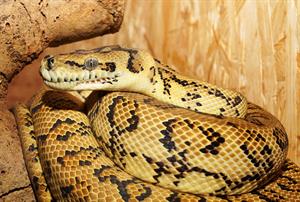PDF chapter test TRY NOW
But the rattlesnake, or ‘rattler’ as it is sometimes called, prefers to avoid people if it possibly can. It holds its tail upright and rattles the end whenever it is disturbed, in the hope that the intruder will go away. However, if its warnings are ignored—and it feels threatened—it will coil ready to bite. But the rattler itself cannot hear the noise its own tail makes. Like most snakes, it ‘hears’ things through vibrations in the ground. If a person walks nearby the snake can feel the movement. But if the same person were to shout, it would not hear a thing. Rattlesnakes are very common and widespread animals, living right across the American continent from Canada to Argentina. They feed on a variety of prey, including mice, voles, rats, chipmunks and many other small animals. Rattlesnakes kill their prey with venom. Like all snakes, they swallow the unfortunate animals whole. Few snakes have to eat more than once a week and some, such as the larger pythons, can survive for a year or more without eating.
Explanation:
The rattler or rattlesnake is also a dangerous reptile. While it avoids people as much as possible and holds its tail upright and shakes it to warn the source of its disturbance. If it is still disturbed or feels threatened, it coils up and strikes.
The rattler cannot hear its own sound, whereas all the snakes can feel the person's movement through the ground vibration. Snakes, though unable to hear sound, can easily detect movement.
Simultaneously, the rattler is a common and widespread animal and lives mostly in both the Americas from Canada to Argentina. They feed animals like mice, voles, rats, chipmunks, etc. And the rattler will also kill the prey by spraying venom and swallowing the animals.
Most snakes can go for a week without food, some pythons can survive for more than a year without eating.

Python
Meanings of difficult words:
Numbers | Words | Meanings |
1. | Voles | Small plant-eating rodents |
2. | Chipmunks | Small ground squirrels having light and dark stripes |
3. | Coil | To turn, to make a loop |
4. | Threatened | To be something that is likely to cause harm to someone or something |
5. | Venom | Poisonous toxin |
6. | Upright | Any object point straight towards the sky |
Reference:
National Council of Educational Research and Training (2006). Honeysuckle. Desert Animals (pp. 112-120). Published at the Publication Division by the Secretary, National Council of Educational Research and Training, Sri Aurobindo Marg, New Delhi.
